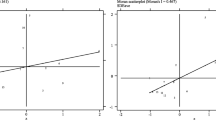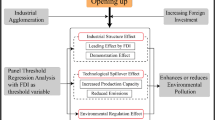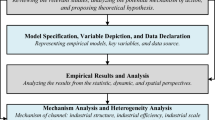Abstract
The purpose of this study is to analyze the environmental pollution effects elicited by industrial agglomeration and to devise necessary changes before and after China going into the New Normal, a contemporary phase of less rapid but more sustainable economic development. An empirical model is constructed based on the Copeland–Taylor model, and empirical research is conducted using statistical panel data derived from 285 Chinese cities between 2003 and 2014. To study the relationship between industrial agglomeration and industrial pollutant emission both before and after the ‘New Normal,’ the sample data are divided into two time periods: 2003–2008 and 2009–2014. Estimated results are as follows. First, industrial agglomeration exacerbates industrial pollution levels overall although the negative environmental effect of industrial agglomeration is weakened following China’s entry into the New Normal phase of economy. Second, both the interaction term of industrial agglomeration and foreign direct investment (FDI) and the interaction term of industrial agglomeration and environmental regulation are negatively related to industrial agglomeration. These findings indicate that FDI and environmental regulation can indirectly reduce industrial pollutant emissions by way of industrial agglomeration.


Similar content being viewed by others
Notes
The data unit of FDI in China’s city book is million US dollar; in order to weed out exchange rate fluctuating, we first convert the data unit into RMB using the annual average exchange rate.
There are 292 prefecture level cities in China now. In order to meet the integrity of the data, this paper just uses data of 285 cities, excluding Zhongwei, Longnan, Chaohu, Bijie, Tongren, Sansha and Lasha.
References
Chapman K (1983) The incorporation of environmental considerations into the analysis of industrial agglomerations—examples from the petrochemical industry in Texas and Louisiana. Geoforum 14(1):37–44
Cheng Z (2016) The spatial correlation and interaction between manufacturing agglomeration and environmental pollution. Ecol Ind 61:1024–1032
Ciccone A, Hall R (1996) Productivity and the density of economic activity. Am Econ Rev 87:54–70
Copeland BR, Taylor MS (1994) North-South trade and the environment. Q J Econ 109(3):755–787
Dasgupta S, Laplante B, Wang H, Wheeler D (2002) Confronting the environmental Kuznets curve. J Econ Perspect 16(1):147–168
de Leeuw FAAM, Moussiopoulos N, Sahm P et al (2001) Urban air quality in larger conurbations in the European Union. Environ Model Softw 16(4):399–414
Dinda S (2004) Environmental Kuznets curve hypothesis: a survey. Ecol Econ 49(4):431–455
Dong B, Gong J, Zhao X (2012) FDI and environmental regulation: pollution haven or a race to the top? J Regul Econ 41(2):216–237
Ebenstein A, Fan M, Greenstone M, He G, Yin P, Zhou M (2015) Growth, pollution, and life expectancy: China from 1991–2012. Am Econ Rev 105(5):226–231
He J (2006) Pollution haven hypothesis and environmental impacts of foreign direct investment: the case of industrial emission of sulfur dioxide (SO2) in Chinese provinces. Ecol Econ 60(1):228–245
He C, Huang Z, Ye X (2014) Spatial heterogeneity of economic development and industrial pollution in urban China. Stoch Environ Res Risk Assess 28(4):767–781
Kamyab H, Din MFM, Ghoshal SK et al (2016a) Chlorella pyrenoidosa mediated lipid production using Malaysian agricultural wastewater: effects of photon and carbon. Waste Biomass Valoriz 7(4):779–788
Kamyab H, Din MFM, Hosseini SE et al (2016b) Optimum lipid production using agro-industrial wastewater treated microalgae as biofuel substrate. Clean Technol Environ Policy 18(8):2513–2523
Levinson A (1996) Environmental regulations and manufacturers’ location choices: evidence from the Census of Manufactures. J Public Econ 62(1–2):5–29
Li Y (2014) Six major challenges facing the economy under the new normal. The China Secur J. http://www.cs.com.cn/xwzx/hg/201412/t20141208_4583139.html. Accessed 8 Dec 2014
List JA, Co CY (2000) The effects of environmental regulations on foreign direct investment. J Environ Econ Manag 40(1):1–20
Lu M, Feng H (2014) An empirical analysis of how intra-province spatial distribution of industries affects pollution. J World Econ 37(7):86–114
Martin P, Mayer T, Mayneris F (2011) Spatial concentration and plant-level productivity in France. J Urban Econ 69(2):182–195
Panayotou T (1993) Empirical tests and policy analysis of environmental degradation at different stages of economic development. IIo Working papers 4
Ren W, Zhong Y, Meligrana J et al (2003) Urbanization, land use, and water quality in Shanghai: 1947–1996. Environ Int 29(5):649–659
Rezania S, Taib SM, Din MFM, Dahalan FA, Kamyab H (2016) Comprehensive review on phytotechnology: heavy metals removal by diverse aquatic plants species from wastewater. J Hazard Mater 318:587–599
Sun P, Yuan Y (2015) Industrial agglomeration and environmental degradation: empirical evidence in Chinese cities. Pac Econ Rev 20(4):544–568
Taylor MS, Copeland BR (2003) Trade, growth, and the environment. Soc Sci Electron Publ 42(1):7–71
Virkanen J (1998) Effect of urbanization on metal deposition in the Bay of Töölönlahti, Southern Finland. Mar Pollut Bull 36(9):729–738
Wang Y, Zhang J, Guo H (2016) Decomposition of electricity consumption in China by primary component analysis. Clean Technol Environ Policy 18(8):2533–2540
Xie R, Yuan Y (2016) Research on the pollution abatement effect of industrial agglomeration’s evolution. Econ Rev 2:18–28
Yang R (2015) Whether industrial agglomeration can reduce environmental pollution or not? China Popul Resour Environ 25(2):23–29
Zeng DZ, Zhao L (2009) Pollution havens and industrial agglomeration. J Environ Econ Manag 58(2):141–153
Zhang J, Chen J (2017) Introduction to China’s new normal economy. J Chin Econ Bus Stud 15(1):1–4
Zhang K, Dou J (2015) Agglomeration and pollution: empirical analysis based on the 287 cities of China. Financ Res 12:32–45
Zhu Y (2009) Scale economies, technical change and total factor productivity of regional manufacturing. J Quant Tech Econ 10:3–18
Acknowledgement
The authors are grateful to the comments from three anonymous referees and editors of Clean Technologies and Environmental Policy. This work was supported by Major Program of National Social Science Foundation of China [15ZDA053] and Key Program of the National Social Science Foundation Project of China [14AZD021].
Author information
Authors and Affiliations
Corresponding author
Rights and permissions
About this article
Cite this article
Liu, S., Zhu, Y. & Du, K. The impact of industrial agglomeration on industrial pollutant emission: evidence from China under New Normal. Clean Techn Environ Policy 19, 2327–2334 (2017). https://doi.org/10.1007/s10098-017-1407-0
Received:
Accepted:
Published:
Issue Date:
DOI: https://doi.org/10.1007/s10098-017-1407-0




